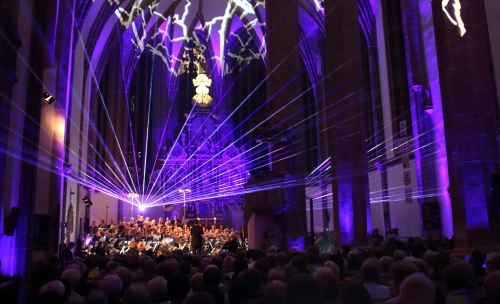Modern worship doesn’t always call for a choir, but there are still many worship services where a choir is involved.
Choirs used to be the staple of the worship experience in most churches—I grew up in a church where they were located in the “choir loft” for the whole service, singing all of the hymns with the rest of us as well as doing a special number or two themselves.
This choir consisted of 40-50 members, accompanied by acoustic piano, and amplification was not a big issue.
As I entered adulthood I took a position as technical director at a mega church that boasted a 100-voice choir and full orchestra. With the orchestra, amplification of the choir was a necessity.
It was during this time that I began working and experimenting with choir mic’ing techniques. There is a lot of information here on PSW about what type of mics to use, where to place them, the 3:1 rule, and so on. Rather than rehash these topics (read more about them here and here), instead I will share some techniques I have found successful.
1 – Augmentation
One of the things that I like to do is to stack the deck in my favor, and at the megachurch, I did this by putting 8 or 16 handheld mics on the best singers. I chose 8 or 16 based on the number of channels I had available—and in a pinch, would settle for 4.
The reason for the increments of four is simple. Most choir music is broken into four parts—soprano, alto, tenor and bass. Adding mics enhanced gain before feedback, and I also tried to apply them to the best singers.
And, I’d sometimes add some effects—primarily reverb—to the signal from these mics, which helped their input fit better with the overall choir sound.
2 – Come Together
A worship leader that I worked with took out the choir section and instead used portable risers. When he first made that change I thought it was for flexibility of location for the choir, but he told me that was only an added benefit—the main reason was to get the choir members close together.
He would put his best singers in the center and then surround them with the rest of the choir using as few risers as possible. His premise (which worked) was that if the choir could hear each other better, they would sing better.
Also, by putting the best singers in the center, the surrounding choir could hear them and rise to their level.
3 – Spice It Up
This works on both stereo (multichannel) systems as well as mono systems. Use a very short decay on a reverb setting (1 to 1.5 seconds). I prefer a hall reverb on a choir, and also add a chorus effect.
This makes a choir of 30-40 sound like a choir of 50-60. In fact, sometimes I back off on the effect because it does not “look” natural—the sound is “bigger” than the group.
As a result, caution should be used when implementing this technique. In addition, it can also greatly reduce gain before feedback—never a good thing with choirs.
4 – Backwards Pan
This only applies if you have a stereo or left, center, right reinforcement system. Pan the mics to the opposite cluster.
If you have two mics, pan the left one to the right cluster and vice versa. This helps gain before feedback as there is greater distance between the mic and the speaker. It also adds a fullness to the sound, particularly in front seating sections where the congregation hears both the acoustic and the reinforced choir sound.
Combining these techniques can help improve your results. I use number 2, 3 and 4 together regularly, but usually shy away from number 1 because I don’t like the visual effect of only some of the choir on handheld mics—to me, it gives the impression the rest of the people are up there just to make the choir look big.
And if none of these ideas produce the results you’re seeking, you can always…
5 – Fake It
I’m almost embarrassed to admit I’ve done this, because it is deceptive: Record the choir ahead of time and add them into the mix.
With this approach, a couple of things helped make it feel natural. First, I recorded our own choir—no “canned” spilt-track voices from a recording done in a professional studio. Second, I (obviously) used a click track to keep the singers in sync with the track.
Finally, I put a lot of the tracked vocals back in the choir monitor, rather than in the house system. Doing this not only made it sound a bit more natural, but it also helped the choir to sing much more confidently.
Choirs are always a challenge, so it helps to have few more tricks in your bag to make it work. And as always, try to take the time to experiment further to achieve an optimum result.
For more PSW Church Sound posts by Gary Zandstra, click here.





















